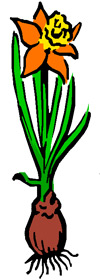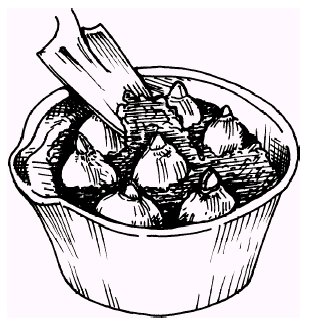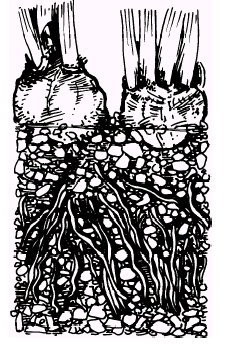|
Get Our Free Newsletter
Home
Previous
Issues
Advertise
Donations
Site
Search
Contact Us
Feature
Articles
Privacy
Pledge
|

 The
opportunity of having a whole glorious season of flowering
daffodils, tulips, and hyacinths indoors during winter is
a reality. A bright floral display and fragrant
aroma is always welcome when snow is on the ground and
bundling up to keep warm outside is a must. Little
(minor) bulbs, such as snowdrops, scilla, muscari,
chionodoxa, and crocus force equally well as the large
(major) bulbs, daffodils, tulips, and hyacinth. Both
the major and minor bulbs are handled in the same way,
although the forcing period may vary slightly. Some
cultivars (early cultivars and those that do not grow too
tall) are better suited for forcing than others.
Catalogs will usually identify forcing
varieties. The
opportunity of having a whole glorious season of flowering
daffodils, tulips, and hyacinths indoors during winter is
a reality. A bright floral display and fragrant
aroma is always welcome when snow is on the ground and
bundling up to keep warm outside is a must. Little
(minor) bulbs, such as snowdrops, scilla, muscari,
chionodoxa, and crocus force equally well as the large
(major) bulbs, daffodils, tulips, and hyacinth. Both
the major and minor bulbs are handled in the same way,
although the forcing period may vary slightly. Some
cultivars (early cultivars and those that do not grow too
tall) are better suited for forcing than others.
Catalogs will usually identify forcing
varieties.
The
term forcing refers to inducing a plant to produce
its shoot, leaf, and flower ahead of its natural schedule
and out of its natural environment. To force hardy
bulbs you need to mimic and compress the process the plant
would undergo outdoors in the garden. The type of
pot (plastic versus clay) is a personal
preference. Plastic pots do not dry out as rapidly
as clay, are easier to clean and lighter in weight, as
well as less expensive. Clay pots have aesthetic
qualities in and of themselves and don’t necessarily
need a basket or covering to be attractive. Bulbs
will grow equally well in either. The pots should be
scrubbed clean before use and clay pots soaked for several
hours to saturate pores.
When
buying bulbs for forcing, always choose first-rate,
top-size varieties. Mail-order bulbs by August or
earlier to ensure adequate time to receive the bulbs by
the first part of October. If you buy from the local
garden center, scrutinize them the way you would produce
at the grocery store; don’t buy bulbs that are soft or
sprouting. High-quality bulbs are necessary because
the bulb contains the food required to produce a flowering
plant.
Since
bulbs need moisture and perfect drainage, a mixture of
equal parts peat moss, potting soil, sand and vermiculite
or perlite is best. Mix thoroughly and moisten with
enough water to a damp consistency. If you
anticipate planting bulbs outdoors after forcing, add 1
teaspoon of 5–10–5 dry fertilizer to every quart of
soil mix to give the bulbs an extra boost after
flowering. Hyacinths, crocus, and narcissi can be
grown in pebbles and water—with no additional nutrients,
however, they are usually completely exhausted and should
be disposed of after blooming. |
| The
next step in planting is to place a few pieces of broken
crockery over the drainage holes, to prevent the soil from
running out initially and clogging later. Fill your
pot half-full of soil mix, then adjust the soil level
until the tops of the bulbs reach the rim of the
container.
Plant
bulbs with the pointed ends up, as close together as
possible, without letting them touch. Tulip and
other bulbs with a flat side should be planted with the
flat side facing the edge of the container. This
will allow the first leaves to form a border around the
edge of the pot.
Add
enough soil mix to fill the pot, and water the bulbs
thoroughly from the top or immerse in a tub of water -
this will settle the soil around the bulbs. Label
each pot with the name of the cultivar, date of planting
and date to bring out of cold storage. |
 |
|

|
Daffodils,
narcissi, crocus, muscari and other bulbs look great in
groups of three, five, or more. Hyacinths look quite
handsome when planted singly, or in groups. Dense
plantings are recommended for minor bulbs.
After
planting, place the pots in a cool, dark place, such as
a cellar or refrigerator to initiate root and shoot
growth. Other suitable environments include an
insulated cold frame, under a porch, or an unheated
garage. Cold storage is a critical step in the
forcing process. Ideally, temperatures should be
35° to 48°F. If necessary, set boxes, pots or
black garbage bags over your potted bulbs to keep them
dark during the cooling period. The medium should
be kept moist through the rooting and cooling
period. After five or six weeks, the roots should
emerge out of the bottom of the containers of the large
hardy bulbs. |
| Forcing
will take about 12 weeks for the early blooming bulbs
(snowdrop, crocus, daffodil) and about 16 weeks for the
tulips. Longer cold storage will result in taller
flowers, while storage time shorter than 13 weeks will
result in smaller plants and sometimes aborted
flowers. A good rule of thumb: when you see the
shoots 2 to 3 inches above the soil and fine white roots emerging
from the drainage holes, it’s time to bring the pots out
of cold storage. At this stage of development, move
the bulbs to a cool location, such as an unheated entryway
or closed off back bedroom, where the temperatures are in
the ’50s. Bulbs should be placed in indirect lighting
and should not be allowed to dry out.
Feed
weekly with a half-strength solution of houseplant
fertilizer. Turning the pots every day or so keeps
the flower stems straight and strong. In a week or two,
the stems will elongate and the buds will become
plump. When the foliage and buds are well developed,
move the pots to a bright, sunny window in the house,
where temperatures are near 65°F. Once the flowers
begin to open, take the plants out of direct sunlight to
prolong the bloom.
You
will be pleased at how quickly the bloom unfolds compared
to weeks, or possibly months, before they would
outside. Hyacinths will bloom for nearly two
wonderfully fragrant weeks if the room is between 65° to
68°F. Iris reticulate and crocus may fail to bloom
or last only a day if temperatures get over 65°F.
After
flowering, cut the flower stems and place the pots in
direct sunlight, keeping the foliage growing until it
begins to die back. As it withers, don’t pull the
leaves off, store the bulbs in the pots in a cool, dry
place until late summer or early fall, at which time they
can be planted into the garden. Attempts to force
the same bulbs indoors will be unsuccessful, as forcing
weakens the bulb and the bloom will be small and
unsatisfactory the following year. Once the bulbs
are back in the garden setting, they will return to a
natural schedule, and in several years will again produce
a wonderful show of flowers.
Some
suggested varieties for forcing are:
Tulips
- Apricot
Beauty, Bing Crosby, Edith Eddy, Mirjorma, Yokohama,
Jingle Bells, Attila, White Dream, Princess Victoria,
White Swallow, Estella Rijnveld
Crocus
- Pickwick,
Rembrance, Flower Record, Peter Pan, Purpurea
Grandiflora
Hyacinths
- Amethyst,
Blue Jacket, Jan Bros, L’Innocence, Pink Pearl,
Delft Blue, Hollyhock, Anna Marie, Violet Pearl, Gypsy
Queen, Carnegie
Muscari
Daffodils
and Narcissi
- Barrett
Browning, Bridal Crown, Dutch Master, Ice Follies,
Paperwhites, Golden Harvest, Spell Binder, Salome,
Pink Charm, Flower Record, Louis Armstrong,
Unsurpassable, Tete-a-Tete, Jenny, Barrett Browning,
Cheerfulness
Others
- Snowdrops,
Dutch Irises, Blue Squill, and Glory-of-the-snow
|
Originally published by Kansas State University Agricultural
Experiment Station and Cooperative Extension Service. Authored by
Nancy R. Anderson, Gus van der Hoeven, Forcing Bulbs, Kansas State
University, November 1998. |
|

 The
opportunity of having a whole glorious season of flowering
daffodils, tulips, and hyacinths indoors during winter is
a reality. A bright floral display and fragrant
aroma is always welcome when snow is on the ground and
bundling up to keep warm outside is a must. Little
(minor) bulbs, such as snowdrops, scilla, muscari,
chionodoxa, and crocus force equally well as the large
(major) bulbs, daffodils, tulips, and hyacinth. Both
the major and minor bulbs are handled in the same way,
although the forcing period may vary slightly. Some
cultivars (early cultivars and those that do not grow too
tall) are better suited for forcing than others.
Catalogs will usually identify forcing
varieties.
The
opportunity of having a whole glorious season of flowering
daffodils, tulips, and hyacinths indoors during winter is
a reality. A bright floral display and fragrant
aroma is always welcome when snow is on the ground and
bundling up to keep warm outside is a must. Little
(minor) bulbs, such as snowdrops, scilla, muscari,
chionodoxa, and crocus force equally well as the large
(major) bulbs, daffodils, tulips, and hyacinth. Both
the major and minor bulbs are handled in the same way,
although the forcing period may vary slightly. Some
cultivars (early cultivars and those that do not grow too
tall) are better suited for forcing than others.
Catalogs will usually identify forcing
varieties.

